Spectrum Frontiers Workshop:
Topics Covered and Avoided
Advanced wireless connectivity in highest spectrum bands on display at FCC Spectrum Frontiers workshop tomorrow https://t.co/idaohfNa68
— The FCC (@FCC) March 9, 2016
On March 10, 2016 FCC held a workshop entitled "Workshop and Tech Demonstration on Spectrum Frontiers and Technological Developments in the Millimeter Wave Bands". The original announcement clarified this a little by saying "exploring the concepts raised in the Commission’s Spectrum Frontiers NPRM and the state of technological developments in the millimeter wave (mmW) bands". The video of the workshop is now available on the FCC's website.
But while the "state of technological developments in the millimeter wave (mmW) bands" was promised, it reality only mobile 5G mmW technology was discussed along with some other 5G issues. Numerous times numerous speakers mentioned "500 MHz" - the goal for reallocation of spectrum to cellular at lower bands. There was't even any discussion of mmW-based backhaul for cellular with the implicit assumption that fiber would miraculously be available for high capacity mmW base stations. (While fiber is the cheapest medium for high bandwidth communications based on equipment costs and while FCC is pushing "dig once" policies, the reality is that fiber is not always everywhere. New fiber installation can be extremely expensive if the costs are not shared with other users or if needed quickly for base station installation. Indeed the term "self-backhaul" is used in Europe for the potential of doing some backhaul in the same band as mobile links was never even mentioned! (Self-backhaul would not be feasible in lower bands but is plausible due to the small wavelengths and high directionality of small antennas at mmW.)
But while "500 MHz" was an allowed diversion of the discussion, any use of spectrum above 71 GHz was not. Contact with several speakers revealed that they were urged to stick to the 5G agenda and not even mention any other topics. So while the mention of "500 MHz" and lower 5G bands was acceptable and the presence of Starry, Inc and FirstNet with totally unrelated topics was acceptable, any mention of fixed use - even for cellular backhaul and any mention of the FCC 95 GHz wall appears to have been verboten! Indeed, nothing was even mentioned above the 71 GHz limit in the Docket 14-177 NPRM. The last panel of federal speakers seemed to focus on either general issues or issues that related mainly to cellular spectrum under 6 GHz.

Present FCC rules have no provisions for licensed or unlicensed above 95 GHz and petitions for such move at a glacial pace while other countries subsidize such R&D
But as we have mentioned previously FCC's barrier to innovation at 95 GHz is quite real. The FCC's inaction on Battelle's RM-11713 102-109.5 GHz petition as well as the IEEE-USA request for a declaratory ruling (Docket 13-259) above on whether technology above 95 GHz is "new technology". (Not to mention the 2.5 years it took for FCC to untangle its apparently unintended wording in the revised Part 5 rules that forbid all experiments in passive bands (which are numerous in the mmW region) regardless of whether the nature of the experiment posed an actual interference threat to passive users.)
While we do not begrudge CTIA members access to mobile spectrum up to 71 GHz or even higher, does CTIA and its wishes like Donald Trump "suck all the oxygen out of the room"? We acknowledge that FCC has a spectrum policy productivity problem, but if that is the issue shouldn't FCC also acknowledge it and show what impact it is having on US competitiveness?
The basic reason why 5G mmW technology is even here now is that FCC took visionary action in 1995 in Docket 94-124 creating the first 60 GHz unlicensed band in the world and in 2003 in Docket 02-148 establishing the world's first 70/80/90 GHz bands just as it took action in 1985 creating the unlicensed ISM bands that are now home to Wi-Fi, Bluetooth and myriad other systems that have changed our world. When FCC took these three decisions they were not in response to major trade association like CTIA, indeed, some trade associations, including CEA/CTA's predecessor, actually opposed the 1985 decision.
It was because FCC stayed true to its original §303(g) mandate and had the confidence to prepare for the future — not spend all of its resources reacting to requests for instant gratification from powerful groups.
Status of IEEE-USA Petition at FCC



![Validate my RSS feed [Valid RSS]](valid-rss-rogers.png)

